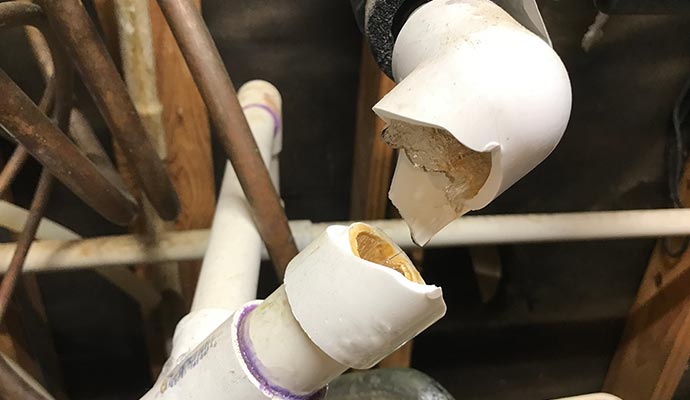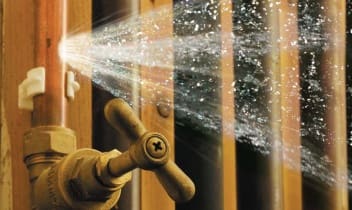How to Fix a Burst Pipe Yourself: A Step-by-Step Guide for Homeowners
How to Fix a Burst Pipe Yourself: A Step-by-Step Guide for Homeowners
Blog Article
Indicators of a Ruptured Pipe: How to Determine and Resolve the Problem
Comprehending the indications of a burst pipe is essential for house owners intending to safeguard their building from significant water damage. Secret signs include water spots on ceilings, unexplained puddles, and changes in water pressure. Additionally, the existence of unpleasant smells or unforeseen spikes in water expenses might point to underlying plumbing problems. Identifying these signs early can assist in prompt action, but understanding just how to effectively attend to the situation is similarly crucial. The subsequent steps might indicate the distinction between a costly calamity and a small hassle.
Water Stains on Ceilings

In addition, the texture of the stained area might come to be softer or sagging, suggesting that the underlying structure is jeopardized - burst pipe. It's vital to check out spots carefully; if they are come with by peeling paint or flaking plaster, this further indicates ongoing dampness issues that could be linked to a burst pipe

Ignoring these indications can cause more substantial damage not only to your ceilings but additionally to the overall integrity of your home. If you observe water stains, it is a good idea to take immediate action by speaking with an accredited plumbing technician. Early intervention can avoid more difficulties, such as mold and mildew growth or structural damage, conserving you money and time in the long run.
Inexplicable Water Pools
Inexplicable water pools in your house can be a substantial sign of a plumbing problem, especially a ruptured pipe. These unexpected buildups of water can emerge in numerous locations, such as under sinks, near appliances, or perhaps in cellars and crawl areas. Identifying the source of these puddles is important, as they can cause extensive water damage and mold growth otherwise attended to quickly.

Sometimes, the presence of standing water may indicate a burst pipe, specifically if it is gone along with by an unexpected decrease in water stress or a recognizable rise in your water expense. If you think a ruptured pipe, it is important to shut off the primary water supply and speak to a certified plumbing right away to analyze the scenario and execute necessary repair services. Prompt intervention can stop more damage and pricey repairs.
Unexpected Changes in Water Stress
An abrupt adjustment in water pressure can be a clear indication of a serious plumbing issue, such as a burst pipeline. House owners might discover this change via fluctuating water flow, where taps supply water inconsistently-- often weakly, and at various other times with excessive pressure. Such abnormalities often originate from a decrease in stress triggered by a burst pipeline, which allows water to escape prior to reaching its designated destination.
In some cases, the stress may raise considerably because of blockages or limitations in the pipes system. This stress accumulation can aggravate existing issues, possibly resulting in further damages within the pipes. It is important to recognize these changes quickly, as they may symbolize that a ruptured pipe looms or has actually currently occurred.
To attend to unexpected adjustments in water stress, house owners need to first look for visible leakages and check the performance look at here now of their pipes fixtures. If the trouble lingers, it is recommended to consult a professional plumbing professional. They can conduct a thorough evaluation of the plumbing system, recognize the source of the stress change, and recommend proper restorative procedures to stop further complications.
Unpleasant Odors in Home
Remaining unpleasant smells in the home can signify underlying plumbing problems, consisting of the possibility of a ruptured pipe. When a pipe bursts, it can bring about the build-up of water in areas that are not easily visible, producing a breeding ground for mold and germs. This stagnation frequently results in musty, nasty scents that might permeate living spaces.
In addition to mold, the existence of sewer smells can suggest that a drain line has been compromised as a result of a ruptured pipe. It positions serious wellness risks and needs prompt attention if wastewater leakages into your home. Home owners must pay close attention to the types of odors; for example, a rotten egg odor may suggest a gas leak, while a sewage-like smell shows a more important pipes concern.
If you find any of these unpleasant scents, it's essential to investigate further. Examine locations where pipelines lie, such as cellars or crawl spaces, for signs of moisture (burst pipe). If issues are found, speaking to an accredited plumber is vital to analyze the circumstance and execute needed repair services, guaranteeing your home remains odorless and secure
Raised Water Expenses
An unanticipated spike in water expenses can offer as a warning indicator of plumbing issues, including the capacity for a ruptured pipe. Click Here Home owners may neglect steady boosts, but a sudden surge in water costs usually suggests a leakage or irrepressible water flow. When a pipe bursts, water leaves into locations where it is not implied to be, leading not only to raised energy expenditures however additionally to prospective residential or commercial property damages.
To recognize if a ruptured pipeline is to criticize, contrast recent water expenses with historical data. It warrants additional examination if the rise is disproportionate to your normal intake. Furthermore, checking your water meter can offer insights; if the meter remains to run while all water sources are shut off, a leak is most likely existing.
Disregarding raised water expenses can result in even more considerable issues, consisting of costly repairs and extensive water damages. By remaining attentive regarding your water use and their website quickly dealing with abnormalities, you can protect your home and financial resources from the effects of a ruptured pipeline.
Conclusion
In recap, acknowledging the indicators of a burst pipe is necessary for minimizing prospective water damages. Water spots on ceilings, unusual pools, abrupt changes in water stress, unpleasant odors, and increased water expenses serve as important signs of plumbing concerns. Prompt identification and activity can avoid extensive damage and pricey repairs. Involving a qualified plumber upon discovering these signs and symptoms is highly suggested to make certain appropriate analysis and resolution of the problem.
Key indications include water stains on ceilings, unusual pools, and variations in water stress.In some instances, the presence of standing water may show a burst pipe, specifically if it is come with by an abrupt decline in water stress or a recognizable increase in your water costs. Property owners might overlook gradual increases, yet an unexpected surge in water costs normally shows a leak or irrepressible water flow. Overlooking raised water bills can result in more considerable issues, including pricey repair work and substantial water damages. Water spots on ceilings, unexplained pools, sudden changes in water stress, unpleasant smells, and raised water costs offer as crucial indications of plumbing problems.
Report this page